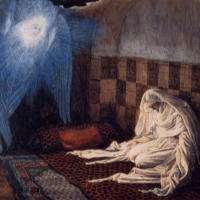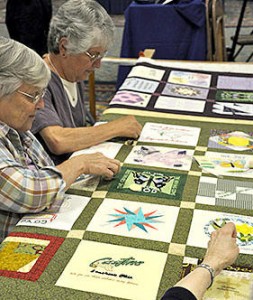On March 25th Catholic Christians celebrate the Feast of the Annunciation of the Lord. Our Gospel passage read at Mass is taken from the first chapter of St. Luke (Luke 1: 26 -38). The Evangelist recounts Mary’s encounter with the Lord’s “messenger”, which is what Angel means. Gabriel’s appearance and message to Mary and her response to God’s invitation teaches us how to live. This year, the Solemnity falls during Lent. Canon # 1251 of the Code of Canon Law reads “Abstinence from meat, or from some other food as determined by the Episcopal Conference, is to be observed on all Fridays, unless a solemnity should fall on a Friday. Abstinence and fasting are to be observed on Ash Wednesday and Good Friday.”
So, Catholics take a break from the Lenten fast. Instead, we Feast. Why? Because the Solemnity takes precedence, it invites us into a profound mystery of the faith, the Incarnation, which is a cause for great Joy and celebration. As the Apostle John writes: “the Word became flesh and made his dwelling among us, and we saw his glory, the glory as of the Father’s only Son, full of grace and truth. “ (John 1:14)
From antiquity the early Christians reflected on how this came about through the cooperation of this little Virgin of Nazareth and what it teaches us about God’s loving plan of salvation. In the midst of all of the challenges we face as Catholic Christians in a Culture which has forgotten God, today we celebrate this loving plan and the remember the heart of the Christian message, conversion through Jesus Christ.
Mary’ role in this plan has significance on so many fronts. One of the earliest titles attributed to her by the early Christians was “the Second Eve”. Whereas the first Eve said no, the early fathers reflected, the Second Eve said “Yes” and creation began anew. Mary was – and is – seen as the “type” of the Church and the model for every Christian, called to say “Yes” to God’s gift.
One of the Cappadocian fathers, Gregory, once wrote “What came about in bodily form in Mary, the fullness of the godhead shining through Christ in the Blessed Virgin, takes place in a similar way in every soul that has been made pure. The Lord does not come in bodily form, for ´we no longer know Christ according to the flesh´, but He dwells in us spiritually and the Father takes up His abode with Him, the Gospel tells us. In this way the child Jesus is born in each of us.” (St. Gregory of Nyssa)
The little Virgin of Nazareth teaches us how to live our real lives in a real world! When the Angel of the Lord appeared, bearing the message and calling her to a special mission, she said “YES.” We must say “Yes” as well and believe that “nothing is impossible with God.” Let’s consider her response to the message: “I am the handmaiden of the Lord; let it be to me according to your Word.” It is in these words that we discover the heart of the Christian vocation.
When Mary spoke those words, human history was forever changed. They came from a deep spiritual reservoir within the heart of a young Jewish girl who was in love with the God of her fathers – Abraham, Isaac and Jacob. Mary´s “Yes” is called the Fiat: in Latin, “Let it be done.” Mary´s Fiat was spoken from a heart filled with love for God.
In a Biblical context, “heart” is a word that means much more than the fleshy organ at the center of our chest cavity. It refers to our center, the core of each of us, the place where our deepest identity is rooted, and from which our fundamental choices about life are made. Mary´s words proceeded from a humble heart.
This young woman was not full of herself, not self-protective, not cynical; she was emptied of herself, in order to be filled with the very Life of God. She was therefore able to completely surrender herself in love, to Love. Her initial assent to the Angel Gabriel´s announcement reveals the very meaning of another Biblical word, “holy”. Holiness is not about looking pious. It is about being selfless. Mary was holy, and she shows us the way to become holy, too.
In the original languages, the words in Holy Scripture which are translated into the English word “holy” mean set apart or consecrated, entirely dedicated to God´s service, given over to God and His worship. If we want to be holy, we need to explore the meaning of these words and make them our own. We are also called to be set apart for the living God. We are to make a place for Him within ourselves and within the world. We are to bear His message through a lifestyle that radiates His love.
It is only by being set apart and consecrated to the Lord that our own personal histories can be truly transformed. This happens through conversion, or “metanoia”, which, in Greek, means “to change.” Our hope for change, for becoming holy, is to open our lives to the One who is the source of all goodness and holiness, Jesus Christ. We are called to respond to His invitation, to say “Yes” to a relationship with Him. That call is not a one time event but a continual invitation.
This is what Mary´s Fiat is all about. In saying Yes to God, as Mary did, we are able to discover the path to conversion, to holiness, to authentic spirituality. Our call to embrace the Fiat and to make it our own is not a formula for easy spiritual growth, nor is it the first in a series of steps that lead to solving the problems of life. The spiritual life is a path, a Way, and it involves a continuing, ongoing walk with the Lord.
He has invited each of us into an intimate, personal, exchange of love. This kind of intimacy with a living, loving God is the interior meaning of Mary´s Fiat, her Magnificat, and her way of life. When we embrace Mary´s Prayer and make it our own, we allow the Love that Mary bore in her body to be incarnated in and through us, too.
Each of us can say “Yes” to God, right now, wherever we are. Each of us can respond with our entire being, with a Fiat of surrendered love. When we do so, our positive response marks the beginning of a participation in the very life of the God who is Father, Son and Holy Spirit. We become sons and daughters of the Most High and enter into the life of the living God. In Him we find our deepest identity, our real selves, through our participation in the One who made us, who redeems us, and who transforms us by His continual grace.
Conversion begins when we say Fiat with our words and our deeds. It introduces to us a new and dynamic way of living with God, and in God. As we lose ourselves in Him, we find ourselves again, made new and completed. This holy exchange-our life for His-is the essence of the spiritual journey. It is not about power but powerlessness. It is not about increase but decrease. It is not about becoming greater but about becoming smaller. In short, true spirituality is about surrender.
Mary teaches us to stay afloat in the ocean of life, with all of its undertows. Mary´s way is to become an ark within, where the same God who became incarnate within her takes up His residence in us. He comes to dwell in all men and women who say “Yes” to Him. Mary invites us to participate in the ongoing incarnation of God´s Love, for the sake of world.
It is an invitation to live “redemptively”. The ongoing re-creative and redemptive work of God´s love continues through us as we learn how to become arks, or dwelling places, through which Incarnate Love comes alive for all those around us. We enter into Christ´s Incarnation as we respond the same way Mary did: “Behold the servant of the Lord. Be it done unto me according to Thy word.”
Mary, in her selflessness, was open to the angel´s visit. She recognized who was speaking. She listened, received and responded. In so doing, she shows us the way to respond to the Lord’s call in our own lives. He still speaks. God initiates a relationship and we respond in surrender to Him. This dynamic, this heavenly road, leads to a new way of life. God comes to take up residence within us and we are called to “birth” Him – through the witness of word and deed – into a world waiting to be born anew.


